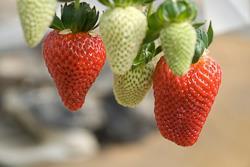
The Australian strawberry season got off to an early start this year, thanks to the planting in Western Australia of ‘leaf-on' runners that are much faster to establish than their traditional ‘leaf-off' plantings.
Leading Western Australian strawberry exporter Ti Produce Marketing’s first shipments arrived in South East Asia in the third week of July, according to export manager Jamie Michael.
'Our new ‘leaf-on' transplants combined with increased plant numbers and favourable weather conditions mean that we are not just expecting an early crop, but we are expecting much larger volumes of fruit for export this season,' Mr Michael told Fruitnet.com.
'With these plantings, we could see yields around 15 per cent higher than average. Last year was quite a low yielding year, so compared to last year's figures the yield could be up as much as 25 per cent. In terms of tonnage, that could see an extra 100 tonnes shipped. I would expect an increase in export volume of at least 20 per cent in 2010.'
As well as the new plantings, growing conditions this campaign have also been ideal, according to Mr Michael. “Weather conditions have been quite favourable for early plant establishment,” he said.
“Plants yields were low last year due to an extended winter and domestic demand kept export prices quite high. Increased plantings and warmer weather indicate that we will have considerably more fruit available for export this year, especially between September and November.”
In spite of all the research being done in the strawberry industry to find new varieties, this year’s Australian exports will almost exclusively consist of the tried-and-true Camarosa variety.
“Californian-bred Camarosa continues to be the most popular variety grown in Western Australia due to its large size, excellent flavour and long shelf life,” said Mr Michael.
“New plantings of ‘leaf-on’ Festival are showing real promise with excellent early yields, sweet flavour and notable aroma. Early trials of Festival have shown the potential to outlast Camarosa under the tougher handling conditions encountered during airfreight, but its smaller size may slow its advance into certain export markets.
“Australian-bred Juliette has failed to live up to expectations. Although it has the ability to produce large volumes of early fruit, its flavour and colour do not measure up against the mainstay of the Western Australian industry, Camarosa.”
Mr Michael explained that new markets in Asia are under assessment, but a lack of workable quarantine protocols means no new markets will be opened this year.
“Singapore, Thailand, Hong Kong, Malaysia and the United Arab Emirates are the key export markets for Australian strawberries,” he asserted.
“New markets in Asia and the subcontinent are being assessed at the moment, but our greatest restriction to these is a lack of quarantine protocol. Ti Produce is currently working with Australian authorities to obtain access to these but we are not likely to achieve access to any additional markets this season.”
Mr Michael believes that increased strawberry production throughout Asia will become a factor for Australian producers in the next few years.
“Australian strawberries are quite well placed in the Asian market due to our ideal strawberry growing climate and close proximity to market,” he said.
“Developments in hothouse production in South East Asia are having a small impact in some markets and will be something that the Australian industry will need to account for in future years.”
In the more immediate term, however, Mr Michael sees water availability as the single most pressing concern for the Australian strawberry industry moving forward.
“As land is developed for housing, water licences applicable to that land are generally withdrawn by the government,” he said.
“Although there is still plenty of available land in close proximity to population bases, the government is not issuing many new water licences as they consider the Perth groundwater supply to already be over-allocated.”






No comments yet